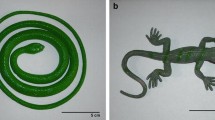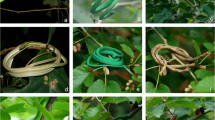Abstract
The responses to a model snake in captive crab-eating macaques (Macaca fascicularis) and captive tufted capuchins (Cebus apella) were investigated. In both species the amount of fear behavior was higher in the presence of the model than during baseline conditions. Unlike the macaques, in the capuchins the frequency of these behaviors decreased across trials. In the two species the amount of explorative and manipulative behaviors and the use of space were also different. Unlike macaques, all capuchins manipulated the objects available in the testing room, and three subjects contacted the apparatus by using objects. Macaques did not show significant preferences for any particular part of the testing room. In both conditions, capuchins used the floor more than macaques did. Further, capuchins increased the use of the floor across experimental trials. Latency to reach the floor was higher in macaques than in capuchins. When on the floor, capuchins spent most of the time close to the snake apparatus. It is proposed that the behavioral differences between capuchins and macaques in the responses to a potential predator indicate that capuchins have a greater propensity to explore and to contact the novel stimulus directly, or by means of objects, than macaques do. These tendencies may lead to the exploitation of novel features in the environment.
Similar content being viewed by others
References
Antinucci, F. (ed.) (1989).Cognitive Structure and Development in Nonhuman Primates, L. Erlbaum Associates Publishers, Hillsdale, N.J.
Altmann, J. (1974). Observational study of behavior: Sampling methods.Behavior 49: 337–367.
Beck, B. B. (1980).Animal Tool Behavior, Garland Press, New York.
Boinski, S. (1988). Use of a club by wild white-faced capuchin (Cebus capucinus) to attack a venomous snake (Bothrops asper).Am. J. Primatol. 14(2): 177–179.
Chapman, C. (1986).Boa constrictor predation and group response in white-facedCebus monkeys.Biotropica 18(2): 171–172.
Chiang, M. (1967). Use of tools by wild macaque monkeys in Singapore.Nature 214: 1258–1259.
Cooper, L. R., and Harlow, H. F. (1961). Note on aCebus monkey's use of a stick as a weapon.Psychol. Rep. 8: 418.
Fedigan, L. M. (1990). Vertebrate predation inCebus capucinus: meat-eating in a neotropical monkey.Folia Primatol. 54 (3–4): 196–205.
Fragaszy, D. M., and Adams-Curtis, L. (1990). Manipulation in tufted capuchin monkey (Cebus apella). I. Form and frequency, with attention to combinatorial activity (submitted for publication).
Goodall, J. (1986).The Chimpanzees of Gombe, Belknap Press of Harvard University Press, Cambridge, Mass.
King, J. E., and Huber, C. B. (1974). Fear of snakes byCebus monkeys. Paper presented to the Western Psychological Association, Annual Meeting, San Francisco.
Kortlandt, A. (1963). Bipedal armed fighting in chimpanzees.Proc. 16th Int. Congr. Zool. 3: 64.
Marler, P. (1965). Communication in monkeys and apes. In DeVore, I. (ed.),Primate Behavior, Holt, Rinehart and Winston, New York, pp. 544–584.
Parker, C. E. (1974). Behavioral diversity in ten species of non-human primates.J. Comp. Physiol. Psychol. 87: 930–937.
Robinson, J. G. (1984). Diurnal variation in foraging and diet in the wedge-capped capuchinCebus olivaceus.Folia Primatol. 43: 216–228.
Torigoe, T. (1985). Comparison of object manipulation among 74 species of non-human primates.Primates 26(2): 182–194.
van Schaik, C. P., and van Noordwijk, M. A. (1989). The special role of maleCebus monkeys in predation avoidance and its effect on group composition.Behav. Ecol. Sociobiol. 24: 265–276.
van Schaik, C. P., van Noordwijk, M. A., Warsono, B., and Sutriono, E. (1983). Party size and early detection of predators in sumatran forest primates.Primates 24(2): 211–221.
Visalberghi, E. (1988). Responsiveness to objects in two social groups of tufted capuchin monkeys (Cebus apella).Am. J. Primatol. 15: 349–360.
Visalberghi, E. (1990). Tool use inCebus.Folia Primatol. 54(3–4): 146–154.
Weigel, R. M. (1978). The facial expression of the brown capuchin monkey (Cebus apella).Behavior 68 (3–4): 250–276.
Westergaard, G. (1988). Lion-tailed macaques (Macaca silenus) manufacture and use tools.J. Comp. Psychol. 102(2): 152–159.
Westergaard, G., and Fragaszy, F. D. (1987). The manufacture and use of tools by capuchin monkeys (Cebus apella).J. Comp. Psychol. 101(2): 159–168.
Wheatley, B. (1988). Cultural behavior and extractive foraging inMacaca fascicularis.Curr. Anthropol. 29(3): 515–519.
Author information
Authors and Affiliations
Rights and permissions
About this article
Cite this article
Vitale, A.F., Visalberghi, E. & De Lillo, C. Responses to a snake model in captive crab-eating macaques (Macaca fascicularis) and captive tufted capuchins (Cebus apella). International Journal of Primatology 12, 277–286 (1991). https://doi.org/10.1007/BF02547588
Received:
Revised:
Issue Date:
DOI: https://doi.org/10.1007/BF02547588




